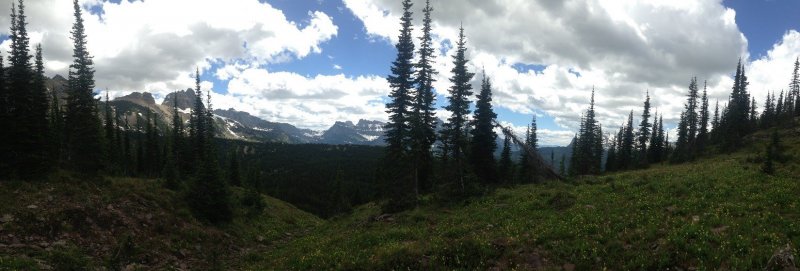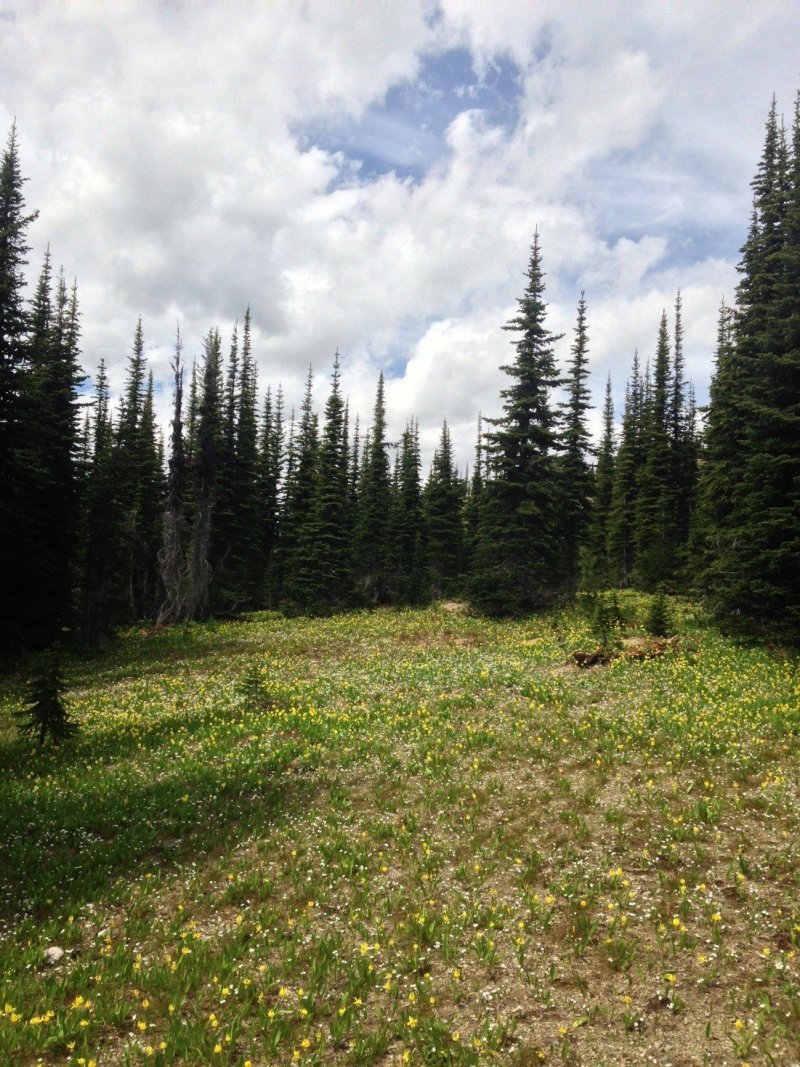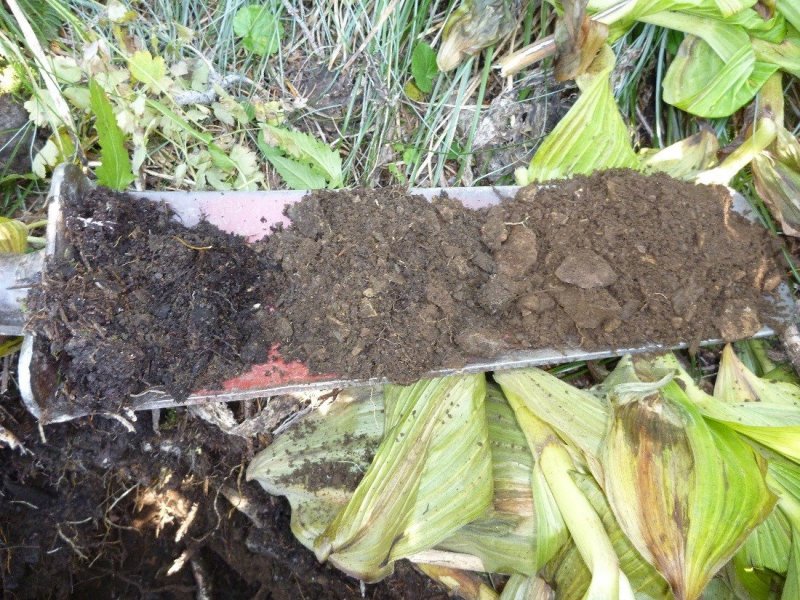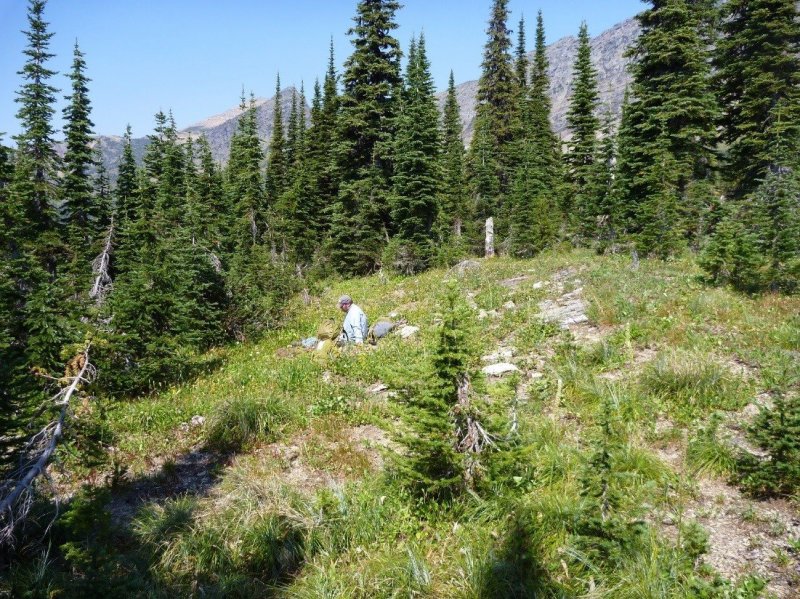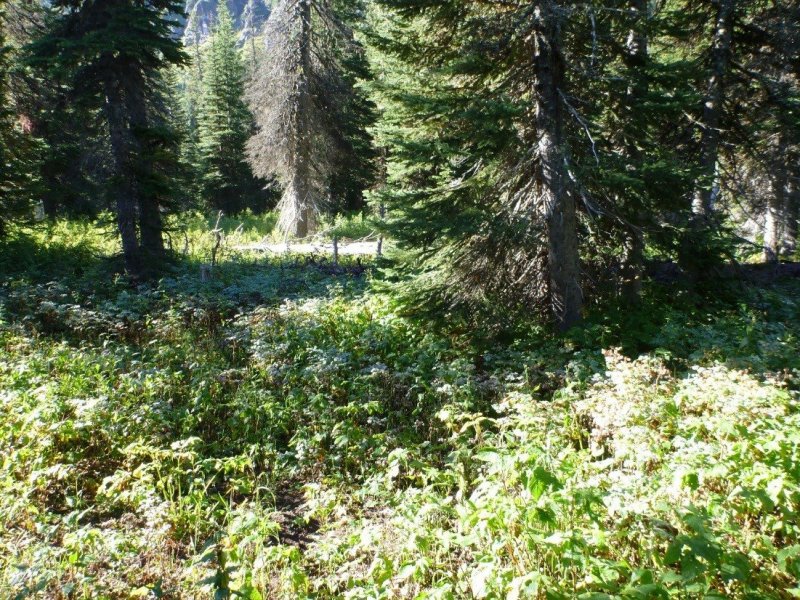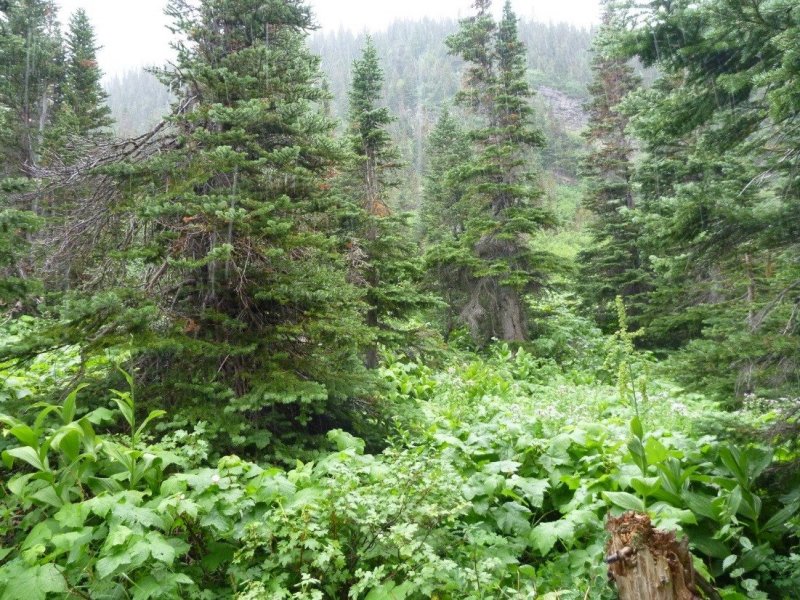Ecological dynamics
The 43A Upper Subalpine Cold Coniferous ecological site is found along the Continental Divide in cold, moist to moderately dry, high elevation sites that span the upper subalpine zone. These sites are above the cold limits of Douglas-fir (Pseudotsuga menziesii), western white pine (Pinus monticola), western larch (Larix occidentalis), with common species including whitebark pine (Pinus albicaulis), lodgepole pine (Pinus contorta), mountain hemlock (Tsuga mertensiana), subalpine fir (Abies lasiocarpa), Engelmann spruce (Picea engelmannii), and subalpine larch (Larix lyallii). This ecological site is below the Alpine Krummholtz Coniferous ecological site in elevation and is not subject to same harsh environment.
Management
The USFS Habitat Type guide states that the basal area on the east side of the Continental Divide for Subalpine fir/Hitchcock’s smooth woodrush is 256+/- ft2 per acre, and the site index at 50 years for Picea is 38+/-17, and Abies is 34+/-8. Timber production on these sites is very low, and rarely an important management objective. Watershed management is very important, as are wildlife sanctuaries. The management of USFS lands is encompassed in the management plan for each National Forest. The management plan for the Flathead NF also has an Appendix B that gives specific management guidelines for habitat types (which relate to our forested ecological sites) found on the forest in relation to current and historic data on forest conditions (Flathead NF Plan, 2001 and Appendix B,). Another guiding USFS document is the Green et al. document (2005) which defines “Old Growth” forest for the northern Rocky Mountains. This document provides an ecologically-based classification of old growth based on forest stand attributes including numbers of large trees, snags, downed logs, structural canopy layers, canopy cover, age, and basal area. While this document finds that the bulk of the pre-settlement upland old growth in the northern Rockies was in the lower elevation areas, ground fire-maintained ponderosa pine/western larch/Douglas-fir types (Losensky, 1992), it does not mean that other types were not common or not important. This could apply to some of the areas of this ecological site.
State 1.0
Subalpine fir dominates the Reference State with the long-lived seral species whitebark pine and Engelmann spruce. Subalpine fir is tall, usually growing more than 15.24 m (50 feet) tall at maturity and is not stunted in the krummholtz form. The understory has the indicator species Hitchcock’s smooth woodrush, which is indicative of cold conditions, and is generally multi-storied with numerous shrub, forb and grass species. Shrubs include rusty menziesia (Menziesia ferruginea) and thinleaf huckleberry (Vaccinium membranaceum). Common forbs and grasses are Hitchcock’s smooth woodrush (Luzula glabrata var. hitchcockii), carex species, blue wildrye (Elymus glaucus), Rocky Mountain groundsel (Packera streptanthifolia), broadleaf arnica (Arnica latifolia), heartleaf arnica (Arnica cordifolia), fireweed (Chamerion angustifolium), lanceleaf springbeauty (Claytonia lanceolata), cow parsnip (Heracleum maximum), beargrass (Xerophyllum tenax), bracted lousewort (Pedicularis bracteosa), arrowleaf ragwort (Senecio triangularis), alpine leafybract aster (Symphyotrichum foliaceum), threeleaf foamflower (Tiarella trifoliata), green false hellebore (Veratrum viride), western meadowrue (Thalictrum occidentale), yellow avalanche lily (Erythronium grandiflorum) and viola species. Primary data was collected in Glacier National Park.
This ecological site is described as having cold and moist to moderately dry site conditions, with a variable, and hard to define, fire return interval, with fire typically of low severity due to discontinuous fuels. Stand-replacement fires can occur after intervals of more than 200 years, typically during drought conditions, and brought up from severe wind-driven crown fires from lower elevations forests (Fischer, 1987). Forest fuels typically are relatively sparse fine fuels and moderate to heavy loads of widely scattered large diameter fuels. These larger fuels are from wind and snow breakage, windthrow, and mortality caused by insects and disease. The normally cool and moist site factors, short fire season, and the sparse, discontinuous, fine surface fuels layer generally leads to low fire severity. If dry conditions exist, such as extended drought, then stand-replacement fire can occur. Vegetation succession afterwards is slow due to the extremely short growing season and cold climate. Site factors such as the cold and moist climate, the high rock and snow cover with low discontinuous surface fuels, and generally low vegetation production are more important to forest development than fire. Lightening fires do occur, but the rain that accompanies thunderstorms and discontinuous fuels limit fire occurrence, spread, and severity.
The general post-disturbance successional phases include the stand initiation phase dominated by herbaceous and shrub species and conifer seedlings, the young stand of pole-sized mixed conifers, the maturing forest of overstory mixed conifer trees, and the Reference Phase dominated by subalpine fir with small gap dynamics. A stand-replacement fire in the mature forest or reference phase would result in the stand initiation phase with species composition of seedlings varying with site conditions. The stand initiation phase will dominate for an extended period, up to 100 years, maintained by site conditions that allow physical disruption of the stand including snow load, windthrow, rock slides, and talus slippage. Whitebark pine, Engelmann spruce, subalpine fir, and subalpine larch seedlings can occupy this site and will progress to the young stand with no major disturbance. Fire is unlikely in these earlier successional phases, but can occur as surface fires or limited extent severe fires, which create vegetative mosaics. The stand progresses to the mature phase, which can sustain stand replacement fires in extended drought due to heavier fuels from breakage or mortality. Without disturbance, the mature stand progresses to the Reference Phase, which is rarely affected by low to moderate severity fires because of the open structure of the forest and discontinuous fire woody fuels. Stand-replacement fires that do occur can return the site to the stand initiation phase.
The significant fire that has occurred in the vicinity of the Continental Divide that affected this ecological site are the Kootenai (burned 8041 acres in 1998) Trapper (burned 18,453 acres in 2003), Rampage Complex (burned 23,237 acres in 2003) and the Red Eagle fire (burned 32,461 acres in 2006).
While subalpine fir can be subjected to a variety of diseases and insect pests, the US Forest Service (USFS) Stand Health map shows that for this specific ecological site, there has not been significant damage to the extent seen in lower elevation ecological sites dominated by subalpine fir and Engelmann spruce. Diseases and insect pests that can affect subalpine fir include root rot, stem decay, bark beetles, and wood borers and defoliators. These can weaken and or kill trees, which results in small openings scattered throughout the forest, or major mortality during an outbreak such as western spruce budworm (Choristoneura occidentalis). Windthrow is a common disturbance after either type of disturbance. Subalpine fir is most commonly susceptible to Armillaria and Annosus root disease, pouch, Indian paint, and red belt fungi which cause stem decay, metallic, roundheaded, and Western balsam bark beetles, fir canker, and defoliators such as Delphinella shoot blight, black mildew, brown felt blight, fir needlecast, snow blight, and fir-blueberry rust.
Community Phase 1.1
Structure: Multistory with small gap dynamics
The overstory is dominated by subalpine fir with small gap dynamics in which small numbers of trees are dead and conifer regeneration is infilling. The overstory tree canopy cover ranges from 15-35 percent. Understory foliar cover is typically high at this community phase (61.4%), and the ground cover is predominantly duff (85%) with low moss cover (4%) and gravel cover (6%). This ecological site has an indicator species of Hitchcock’s smooth woodrush, which is always present. The typical understory can be dominated by either beargrass, rusty menziesia or thinleaf huckleberry and has a diverse shrub component (11 sites of canopy cover). Only at two sites were there no shrubs present and the understory was dominated by Hitchcock’s smooth woodrush and yellow avalanche lily and lanceleaf springbeauty. From foliar data collected at 6 sites, the vegetation structure is one of moderately statured trees (9-15m or 30-49 or more feet tall), and a multilayered understory of medium-structured shrubs ranging from 76-102cm (30-40 inches) tall, and can include rusty menziesii, Scouler’s willow, Lyall’s angelica and current species. The next layer is 51-76cm (20-30 inches) tall and includes rose meadowsweet, cow parsnip and western meadowrue. The next layer is 25-51 cm (10-20 inches) tall and includes white spirea, thinleaf huckleberry, and beargrass. The lowest layer of forbs and grasses 3-25 cm (1-10 inches) tall includes fireweed, trailplant, Hitchcock’s woodrush, threeleaf foamflower and fragrant bedstraw. At these higher elevations subalpine fir is slow growing and infill can take several decades, sustaining the multistory structure of this community. The presence of root rot pockets can shift the composition of this community away from its host specie. This ecological site must have a presence of woodrush and sometimes this is dominant. At this phase Armillaria root rot, and to a minor degree defoliation by Western Spruce budworm, can be a threat.
Community Phase Pathway 1.1A
This pathway represents a larger disturbance: an insect infestation, wind storm, or rot pocket would create this forest structure. Areas of regeneration would range from approximately 2 to 5 acres.
Forest Overstory
Forest canopy: Canopy cover ranges from 15-35 percent
Site index at 100 years: Subalpine fir=40-50 Engelmann spruce= 40-60
Community Phase 1.2:
Structure: High cover of herbaceous and shrub species with patchy clumps of regeneration of seedlings and saplings.
Community Phase 1.2 is a forest in the stand initiation phase, possibly with scattered remnant mature trees. The composition of the seedlings depends upon the natural seed sources available, which generally include whitebark pine, Engelmann spruce, subalpine fir, and subalpine larch. The canopy cover is very low. This phase is tolerant to Armillaria root rot in general.
Community Phase Pathway 1.2A
This pathway represents continued growth over time with no further major disturbance.
Community Phase 1.3:
Structure: Clumps of single story conifer species including whitebark pine, Engelmann spruce, subalpine fir, and subalpine larch.
This phase may be tolerant to some types of Armillaria root rot strains and not others.
Community Phase Pathway 1.3A
This pathway represents continued growth over time with no further major disturbance.
Community Phase 1.4:
Structure: Mature trees of mixed conifers including whitebark pine, Engelmann spruce, subalpine fir, and subalpine larch.
Can be affected by Armillaria root rot.
Community Phase Pathway 1.4A
This pathway represents continued growth over time with no further major disturbance.
Community Phase Pathway 1.4B
This pathway represents major disturbance such as Armillaria root rot, stand-replacement fire, or pest outbreak.
State 2.0
Another disease affecting the 43A UPPER SUBALPINE COLD CONIFEROUS ecological site is root rot. Armillaria root disease is the most common root disease fungus in this region, especially prevalent west of the Continental Divide. It may be difficult to detect until it has killed enough trees to create large root disease pockets or centers, ranging in size from a fraction of an acre to hundreds of acres. The root disease spreads from an affected tree to its surrounding neighbors through root contact. The root disease affects the most susceptible tree species first, leaving less susceptible tree species that mask its presence. When root rot is severe, the pocket has abundant regeneration or dense brush growth in the center. In western Montana and northern Idaho, Armillaria is present in most stands with diffuse mortality and large and small root disease centers. The disease pattern is one of multiple clones merging to form essentially continuous coverage of sites. Grouped as well as dispersed mortality can occur throughout the stand. A mosaic of brushy openings, patches of dying trees, and apparently unaffected trees may cover large areas. There can be highly significant losses, usually requiring species conversion in the active management approach. Management tactics include to identify the type of Armillaria root disease present and manage for pines and larch. Pre-commercial thinning may improve the growth and survival of pines and larch. Avoid harvests that leave susceptible species (usually Douglas-fir or true firs) as crop trees (Hagle, 2010). There has been a link determined between parent material and susceptibility to root disease, and metasedimentary parent material is thought to increase the risk of root disease. Glacier National Park is dominated by metasedimentary parent material, and may be more at risk than other areas to root disease (Kimsey et al., 2012). If a stand sustains very high levels of roots disease mortality, then a coniferous stand could cross a threshold and become a shrubland, once all conifers are gone (Kimsey et al., 2012).
State 1
Reference
Subalpine fir dominates the Reference State with the long-lived seral species whitebark pine and Engelmann spruce. Subalpine fir is tall, usually growing more than 15.24 m (50 feet) tall at maturity and is not stunted in the krummholtz form. The understory has the indicator species Hitchcock’s smooth woodrush, which is indicative of cold conditions, and is generally multi-storied with numerous shrub, forb and grass species. Shrubs include rusty menziesia (Menziesia ferruginea) and thinleaf huckleberry (Vaccinium membranaceum). Common forbs and grasses are Hitchcock’s smooth woodrush (Luzula glabrata var. hitchcockii), carex species, blue wildrye (Elymus glaucus), Rocky Mountain groundsel (Packera streptanthifolia), broadleaf arnica (Arnica latifolia), heartleaf arnica (Arnica cordifolia), fireweed (Chamerion angustifolium), lanceleaf springbeauty (Claytonia lanceolata), cow parsnip (Heracleum maximum), beargrass (Xerophyllum tenax), bracted lousewort (Pedicularis bracteosa), arrowleaf ragwort (Senecio triangularis), alpine leafybract aster (Symphyotrichum foliaceum), threeleaf foamflower (Tiarella trifoliata), green false hellebore (Veratrum viride), western meadowrue (Thalictrum occidentale), yellow avalanche lily (Erythronium grandiflorum) and viola species. Primary data was collected in Glacier National Park.
This ecological site is described as having cold and moist to moderately dry site conditions, with a variable, and hard to define, fire return interval, with fire typically of low severity due to discontinuous fuels. Stand-replacement fires can occur after intervals of more than 200 years, typically during drought conditions, and brought up from severe wind-driven crown fires from lower elevations forests (Fischer, 1987). Forest fuels typically are relatively sparse fine fuels and moderate to heavy loads of widely scattered large diameter fuels. These larger fuels are from wind and snow breakage, windthrow, and mortality caused by insects and disease. The normally cool and moist site factors, short fire season, and the sparse, discontinuous, fine surface fuels layer generally leads to low fire severity. If dry conditions exist, such as extended drought, then stand-replacement fire can occur. Vegetation succession afterwards is slow due to the extremely short growing season and cold climate. Site factors such as the cold and moist climate, the high rock and snow cover with low discontinuous surface fuels, and generally low vegetation production are more important to forest development than fire. Lightening fires do occur, but the rain that accompanies thunderstorms and discontinuous fuels limit fire occurrence, spread, and severity.
The general post-disturbance successional phases include the stand initiation phase dominated by herbaceous and shrub species and conifer seedlings, the young stand of pole-sized mixed conifers, the maturing forest of overstory mixed conifer trees, and the Reference Phase dominated by subalpine fir with small gap dynamics. A stand-replacement fire in the mature forest or reference phase would result in the stand initiation phase with species composition of seedlings varying with site conditions. The stand initiation phase will dominate for an extended period, up to 100 years, maintained by site conditions that allow physical disruption of the stand including snow load, windthrow, rock slides, and talus slippage. Whitebark pine, Engelmann spruce, subalpine fir, and subalpine larch seedlings can occupy this site and will progress to the young stand with no major disturbance. Fire is unlikely in these earlier successional phases, but can occur as surface fires or limited extent severe fires, which create vegetative mosaics. The stand progresses to the mature phase, which can sustain stand replacement fires in extended drought due to heavier fuels from breakage or mortality. Without disturbance, the mature stand progresses to the Reference Phase, which is rarely affected by low to moderate severity fires because of the open structure of the forest and discontinuous fire woody fuels. Stand-replacement fires that do occur can return the site to the stand initiation phase.
The significant fire that has occurred in the vicinity of the Continental Divide that affected this ecological site are the Kootenai (burned 8041 acres in 1998) Trapper (burned 18,453 acres in 2003), Rampage Complex (burned 23,237 acres in 2003) and the Red Eagle fire (burned 32,461 acres in 2006).
While subalpine fir can be subjected to a variety of diseases and insect pests, the US Forest Service (USFS) Stand Health map shows that for this specific ecological site, there has not been significant damage to the extent seen in lower elevation ecological sites dominated by subalpine fir and Engelmann spruce. Diseases and insect pests that can affect subalpine fir include root rot, stem decay, bark beetles, and wood borers and defoliators. These can weaken and or kill trees, which results in small openings scattered throughout the forest, or major mortality during an outbreak such as western spruce budworm (Choristoneura occidentalis). Windthrow is a common disturbance after either type of disturbance. Subalpine fir is most commonly susceptible to Armillaria and Annosus root disease, pouch, Indian paint, and red belt fungi which cause stem decay, metallic, roundheaded, and Western balsam bark beetles, fir canker, and defoliators such as Delphinella shoot blight, black mildew, brown felt blight, fir needlecast, snow blight, and fir-blueberry rust.
Community 1.1
Reference Phase
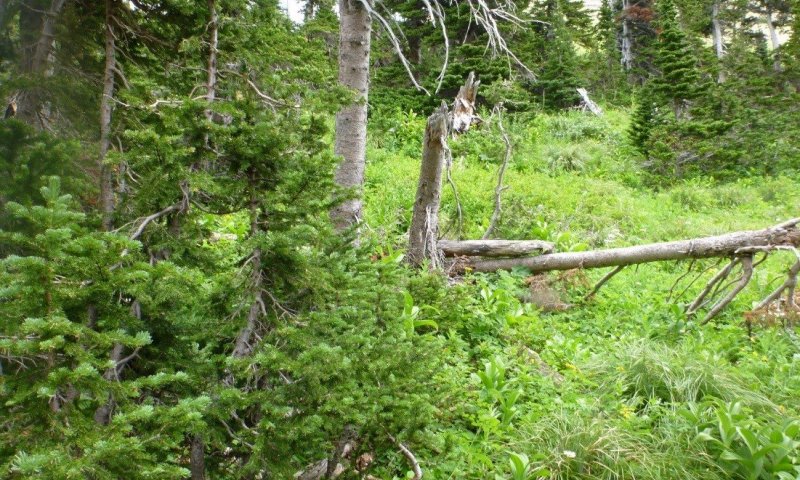
Figure 13. View of this ecological site with high foliar cover of shrubs, grasses and forbs between tree ribbons. Trees at this ecological site are taller, not krummholtz.
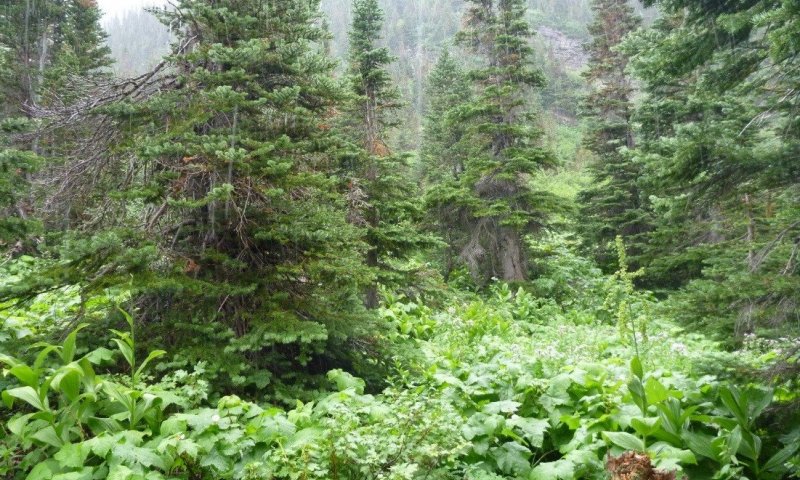
Figure 14. Landscape view of site with thick understory of moderate to tall statured shrubs and forb species.
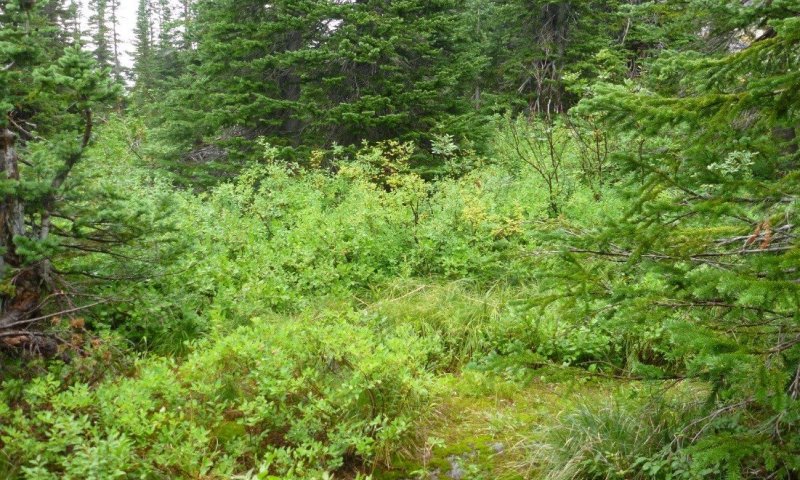
Figure 15. Site view noting lush understory of medium statured shrubs and taller tree islands with discontinuous fuel layer.
Structure: Multistory with small gap dynamics
The overstory is dominated by subalpine fir with small gap dynamics in which small numbers of trees are dead and conifer regeneration is infilling. The overstory tree canopy cover ranges from 15-35 percent. Understory foliar cover is typically high at this community phase (61.4%), and the ground cover is predominantly duff (85%) with low moss cover (4%) and gravel cover (6%). This ecological site has an indicator species of Hitchcock’s smooth woodrush, which is always present. The typical understory can be dominated by either beargrass, rusty menziesia or thinleaf huckleberry and has a diverse shrub component (11 sites of canopy cover). Only at two sites were there no shrubs present and the understory was dominated by Hitchcock’s smooth woodrush and yellow avalanche lily and lanceleaf springbeauty. From foliar data collected at 6 sites, the vegetation structure is one of moderately statured trees (9-15m or 30-49 or more feet tall), and a multilayered understory of medium-structured shrubs ranging from 76-102cm (30-40 inches) tall, and can include rusty menziesii, Scouler’s willow, Lyall’s angelica and current species. The next layer is 51-76cm (20-30 inches) tall and includes rose meadowsweet, cow parsnip and western meadowrue. The next layer is 25-51 cm (10-20 inches) tall and includes white spirea, thinleaf huckleberry, and beargrass. The lowest layer of forbs and grasses 3-25 cm (1-10 inches) tall includes fireweed, trailplant, Hitchcock’s woodrush, threeleaf foamflower and fragrant bedstraw. At these higher elevations subalpine fir is slow growing and infill can take several decades, sustaining the multistory structure of this community. The presence of root rot pockets can shift the composition of this community away from its host specie. This ecological site must have a presence of woodrush and sometimes this is dominant. At this phase Armillaria root rot, and to a minor degree defoliation by Western Spruce budworm, can be a threat.
Forest overstory. Trees form a multi-storied stand of subalpine fir with lower cover of whitebark pine, lodgepole pine and Englemann spruce. The subcanopy is predominantly subalpine fir and lower cover of western larch, whitebark pine, lodgepole pine, Englemann spruce and Douglas fir. There may be pockets of quaking aspen.
Forest understory. The forest understory is diverse with multiple height shrub and herbaceous layers. Medium stature shrubs include thinleaf huckleberry, grouse whortleberry and rusty menziesia. Herbacous lower layers include heartleaf arnica, fireweed, yellow avalanche-lily.
Table 6. Soil surface cover
| Tree basal cover |
1-10%
|
| Shrub/vine/liana basal cover |
1-10%
|
| Grass/grasslike basal cover |
0-2%
|
| Forb basal cover |
1-10%
|
| Non-vascular plants |
0-5%
|
| Biological crusts |
0-1%
|
| Litter |
70-80%
|
| Surface fragments >0.25" and <=3" |
0-5%
|
| Surface fragments >3" |
0-5%
|
| Bedrock |
0%
|
| Water |
0%
|
| Bare ground |
0-10%
|
Table 7. Canopy structure (% cover)
| Height Above Ground (ft) |
Tree |
Shrub/Vine |
Grass/
Grasslike |
Forb |
| <0.5 |
0-5% |
1-20% |
0-2% |
1-10% |
| >0.5 <= 1 |
0-5% |
1-20% |
0-2% |
0-10% |
| >1 <= 2 |
0-5% |
1-20% |
– |
0-10% |
| >2 <= 4.5 |
0-5% |
0-5% |
– |
– |
| >4.5 <= 13 |
0-5% |
– |
– |
– |
| >13 <= 40 |
0-10% |
– |
– |
– |
| >40 <= 80 |
5-20% |
– |
– |
– |
| >80 <= 120 |
5-30% |
– |
– |
– |
| >120 |
– |
– |
– |
– |
Community 1.2
Patchy Clumps, Single Story
Structure: High cover of herbaceous and shrub species with patchy clumps of regeneration of seedlings and saplings.
Community Phase 1.2 is a forest in the stand initiation phase, possibly with scattered remnant mature trees. The composition of the seedlings depends upon the natural seed sources available, which generally include whitebark pine, Engelmann spruce, subalpine fir, and subalpine larch. The canopy cover is very low. This phase is tolerant to Armillaria root rot in general.
Community 1.3
Clumps of Single Story Whitebark
Structure: Clumps of single story conifer species including whitebark pine, Engelmann spruce, subalpine fir, and subalpine larch.
This phase may be tolerant to some types of Armillaria root rot strains and not others.
Community 1.4
Stand Break Up by Wind
Structure: Mature trees of mixed conifers including whitebark pine, Engelmann spruce, subalpine fir, and subalpine larch.
Can be affected by Armillaria root rot.
Pathway 1.1A
Community 1.1 to 1.2
This pathway represents a larger disturbance: an insect infestation, wind storm, or rot pocket would create this forest structure. Areas of regeneration would range from approximately 2 to 5 acres.
Pathway 1.2A
Community 1.2 to 1.3
This pathway represents continued growth over time with no further major disturbance.
Pathway 1.3A
Community 1.3 to 1.4
This pathway represents continued growth over time with no further major disturbance.
Pathway 1.4A
Community 1.4 to 1.1
This pathway represents continued growth over time with no further major disturbance.
Pathway 1.4B
Community 1.4 to 1.2
This pathway represents major disturbance such as Armillaria root rot, stand-replacement fire, or pest outbreak.
State 2
Root Rot
Another disease affecting the 43A UPPER SUBALPINE COLD CONIFEROUS ecological site is root rot. Armillaria root disease is the most common root disease fungus in this region, especially prevalent west of the Continental Divide. It may be difficult to detect until it has killed enough trees to create large root disease pockets or centers, ranging in size from a fraction of an acre to hundreds of acres. The root disease spreads from an affected tree to its surrounding neighbors through root contact. The root disease affects the most susceptible tree species first, leaving less susceptible tree species that mask its presence. When root rot is severe, the pocket has abundant regeneration or dense brush growth in the center. In western Montana and northern Idaho, Armillaria is present in most stands with diffuse mortality and large and small root disease centers. The disease pattern is one of multiple clones merging to form essentially continuous coverage of sites. Grouped as well as dispersed mortality can occur throughout the stand. A mosaic of brushy openings, patches of dying trees, and apparently unaffected trees may cover large areas. There can be highly significant losses, usually requiring species conversion in the active management approach. Management tactics include to identify the type of Armillaria root disease present and manage for pines and larch. Pre-commercial thinning may improve the growth and survival of pines and larch. Avoid harvests that leave susceptible species (usually Douglas-fir or true firs) as crop trees (Hagle, 2010). There has been a link determined between parent material and susceptibility to root disease, and metasedimentary parent material is thought to increase the risk of root disease. Glacier National Park is dominated by metasedimentary parent material, and may be more at risk than other areas to root disease (Kimsey et al., 2012). If a stand sustains very high levels of roots disease mortality, then a coniferous stand could cross a threshold and become a shrubland, once all conifers are gone (Kimsey et al., 2012).
Community 2.1
Armillatia Root Rot
Metasedimentary and quartzite parent material (vitrandic soils on south and west aspects). Shrubland with no trees.
Time=50yrs
Transition T1A
State 1 to 2
High density fir becomes infected.
Restoration pathway R2A
State 2 to 1
Active management and seeding of true pine and larch species.


